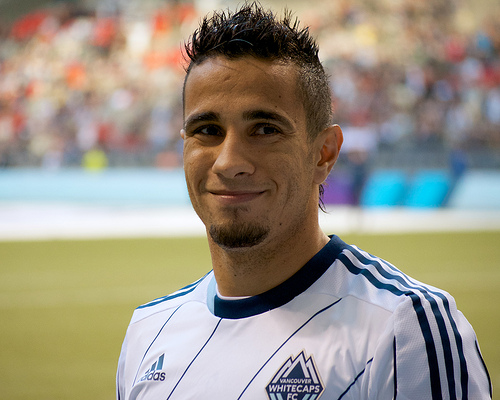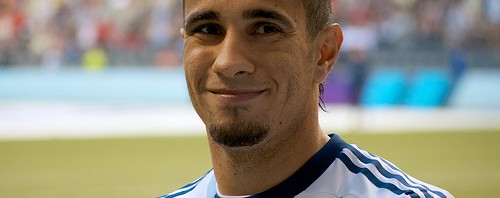 In the two and a half years of the Whitecaps MLS tenure, there has been no more polarizing player than Camilo da Silva Sanvezzo. Fans of the diminutive Brazilian point to his club-leading goal-scoring numbers, his willingness to get a head on a cross, his penchant for taking on defenders in the box and drawing penalties. His detractors, meanwhile, accuse him of being an unabashed diver, and a selfish player to boot. Deserving penalties those were not, say they, and why doesn’t Camilo ever pass the ball? You can throw me firmly in the former category. I love Camilo, but I also like to have some empirical backup for my opinions.
In the two and a half years of the Whitecaps MLS tenure, there has been no more polarizing player than Camilo da Silva Sanvezzo. Fans of the diminutive Brazilian point to his club-leading goal-scoring numbers, his willingness to get a head on a cross, his penchant for taking on defenders in the box and drawing penalties. His detractors, meanwhile, accuse him of being an unabashed diver, and a selfish player to boot. Deserving penalties those were not, say they, and why doesn’t Camilo ever pass the ball? You can throw me firmly in the former category. I love Camilo, but I also like to have some empirical backup for my opinions.
More after the break.

For those of you who also follow hockey, you may have heard of a stat called “Corsi” which has been gaining popularity in recent years. Corsi is essentially a plus/minus stat for shots directed at net instead of goals, and has shown itself a more reliable indicator of a player’s on-ice performance than other more conventional statistics. It’s also a reasonable indicator of how the run of play is going. Even if a team is down 1-0 or 2-0, looking at how many shot attempts are being put towards each goal tells you a lot about the game. Once you get that data, you can begin comparing players. To begin, we take the shot differential (Corsi) while a player is on the pitch and subtract the shot differential when the player is off the pitch.
For example: Jun Marques Davidson has been on the field for 112 shots for, or 13.75 for every 90 for every 90 minutes of play (for ease of reading I’ll refer to this as per match), and 105 shots against, or 12.89/match. That’s a +0.86/match shot differential when he’s on the field, a slightly positive advantage over the opposition. While Davidson has been on the bench, however, the Caps have had 51 shots for, or 17.86/match, and 29 shots against, or 10.16 per match — a dramatic +7.70/match shot differential when he’s off the field. On average, the Caps direct 6.84 more shots on target than their opponents for every ninety minutes that JMD sits his defensive ass on the bench. That’s not good.
At the other end of the spectrum is Camilo. When Camilo is on the park Vancouver dominates the play, outshooting the opposition 109-60. When he’s on the bench, Vancouver is outshot 54-74. Crunch the numbers and you get a team-leading relative shot differential of +12.17. The Whitecaps will take, on average, 8 more shots for every 90 minutes the Brazilian plays, and concede 4 fewer.
Some of the knocks on Camilo are legitimate: he doesn’t work hard enough to stay on his feet. I’m still not convinced he dives, but he certainly doesn’t try to fight through contact. Some are overblown: calling him selfish is ridiculous when he led the team in assists last year and set up 1.17 shots/match, fifth best on the team.
Another one I’ve heard is that Camilo doesn’t have a strong left foot. This is MLS, not the EPL. There aren’t a lot of ambidextrous players in these parts. What I do know is that as Camilo goes, so does the Whitecaps offense. Here’s hoping Martin Rennie sees fit to keep him in the lineup for the foreseeable future.
For those of you that have made it this far, the data I’m working from can be found here. Note that Vancouver outshot Edmonton 41-17 over their two games, leading to some decidedly odd numbers for players like YP Lee and Alain Rochat, who missed those drubbings.


I was just wondering about Corsi numbers and soccer players yesterday. Good to know I’m not the only one that wonders.
I’ve been thinking about this stuff for a long time so it makes me happy to see Whitecaps writing gettin’ nerdy and backing up opinions on player value with better data.
I know that you know, because I’ve noticed that we follow a bunch of the same hockey numbers geeks on Twitter, that even more nuanced measures like Corsi have to be taken in context – and this is where I think the differences between hockey and soccer get really interesting.
For example, what do you think of the impact of player usage patterns, and how should we assess that in soccer? Obviously a player who comes off the bench at 80′ is playing a different role than the player he’s replacing, but how do we call “tough minutes” vs “soft minutes”? Is deployment in set pieces kinda analogous to zone starts? I’m pretty sure there’s a ton of factors that can bring nuance into analysis that I haven’t even thought of.
And here’s the biggie to me – these concepts have been shown pretty solidly now in hockey to correlate with meaningful results over a large enough data set – will we find the same level of validity of the concept of Corsi in soccer? My gut tells me that shot *quality* should be a bigger factor in soccer than in hockey, but my gut tells me all kinds of irrational stuff and I’ve nothing to back that up.
Got more nerdy goodness? Do share!
That’s a lot all at once. Ok. I think the super-sub role is actually pretty transient. If a guy is earning big minutes late in the game he’s probably pretty close to the starting lineup, meaning his numbers should regress over time. Manneh, for example, is second on the team behind Camilo. That’s in about 180 minutes of playing mostly while the Caps were chasing the game, meaning his totals are inflated by score effects. As soon as he stops being just a super sub, I think he comes back to earth. Given that, I think it’s reasonable to look at some sort of adjusted number to take those score effects into account, but that would be a whopper of a spreadsheet formula.
For tough minutes vs soft minutes, I don’t think that’s near as relevant in soccer. In hockey it’s crucial, because your lines are constantly rotating, and its important to know whether a player is getting outplayed by a really good line or a really bad line. In soccer, it’s more the strength of the team as a whole that matters, and that should even out over time.
I don’t know enough about tactics to know whether set piece deployments would affect your shot totals. It might. For Corsi numbers, though, it’s immaterial. All that matters is you’re on the pitch when the shot is taken.
Totally agree about nuance, but we’re a long way from being able to meaningfully interpret any of those nuances. For starters, these stats would have to be compiled properly for every team in the league. Also, how do you deal with NASL or CONCACAF competition?
Finally, shot quality matters to some extent in both sports. That’s why they keep track of scoring chances in hockey. Problem is, I don’t know what does or should constitute a scoring chance in soccer. There’s no accepted definition.
I think the question is how you would differentiate between “scoring chance” and “shot attempt” — the latter is a stat already compiled in international football. Example: a couple of games ago, Darren Mattocks was given a brilliant pass at the edge of the six-yard box by Nigel Reo-Coker. Mattocks dove for it, and the ball went through his feet and out past the far post.
By hockey standards, that would not register as a shot, a shot attempt, a blocked shot or any other shot. However, given his prime position and glorious opportunity to tap the ball home, it would count as a scoring chance. (Note: I don’t know if there is a formula for deciding hockey’s scoring chances, or if it’s just a judgement call by in-rink stats keepers. Some are obvious, like the Mattocks example above.)
In another case, Brad Rusin headed the ball on a set piece – it hit the post, then the keeper, then the post again before being cleared. That was considered a shot attempt, but not a shot on goal. It would most certainly qualify as a scoring chance.
Thoughts, gents?